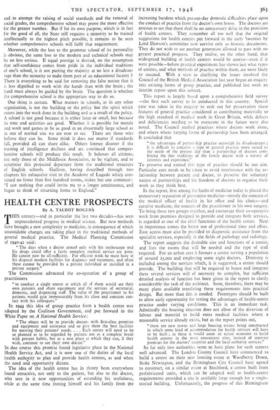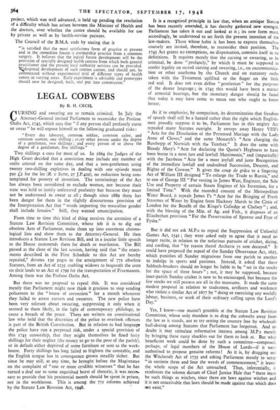HEALTH CENTRE PROSPECTS
By A. TALBOT ROGER'S
THIS century—and in particular the last two decades—has seen unprecedented progress in medical science. But new methods have brought a new complexity to medicine, in consequence of which unavoidable changes are taking place in the traditional methods of
general medical practice. The Medical Planning Commission of 1940-42 said:
"The days when a doctor armed only with his stethoscope and his drugs could offer a fairly complete medical service are gone. He cannot now be all-sufficient. For efficient work he must have at his disposal modern facilities for diagnosis and treatment, and often these cannot be provided by a private individual or installed in a private surgery."
The Commission advocated the co-operation of a group of practitioners
"to conduct a single centre at which all of them would see their own patients and share equipment and the services of secretarial, domestic, and dispensing staff. The value of the practitioner to his patients would gain immeasurably from his close and constant con- tact with his colleagues."
In 1944 this idea of group practice from a health centre was adopted by the Coalition Government, and put forward in the White Paper on A National Health Service:
"The object will be to provide doctors with first-class premises and equipment and assistance and so give them the best facilities for meeting their patients' needs. . . . Each centre will need to be so planned as to be regarded by patients not as a complete break with present habits, but as a new place at which they can, if they wish, continue to see their own doctor."
In due course this promise found legislative place in the National Health Service Act, and it is now one of the duties of the local health authority to plan and provide health centres, as and when the need and opportunity dictate.
The idea of the health centre has in theory been everywhere found attractive, not only to the patient, but also to the doctor, who sees in it new opportunities of extending his usefulness, while at the same time freeing himself and his family from the increasing burdens which present-day domestic difficulties place upon the conduct of practice from the doctor's own house. The doctors are anxious to see that there shall be no unnecessary delay in the provision of health centres. They remember all too well that the original suggestions for health centres put forward in the early 'twenties by Lord Dawson's committee now survive only as historic documents.
They do not wish to see another generation allowed to pass with no greater practical progress. They realise, on the other hand, that
widespread building of health centres would be unwise—even if it were possible—before practical experiment has shown just what types of centres, and what methods of practice within them, are most likely to succeed. With a view to clarifying the issues involved the
Council of the British Medical Association last year began an enquiry into existing forms of group practice, and published last week an interim report upon this subject.
This report is largely based upon a comprehensive field survey —the first such survey to be conducted in this country. Special care was taken in the enquiry to seek out for preservation those features of general practice considered as contributing materially to the high standard of medical work in Great Britain, while defects and deficiencies needing to be overcome in the future were also noted. The Council studied practices where doctors work alone, and others where varying forms of partnership have been arranged. It concluded that
"the advantages of partnership practice outweigh its disadvantages ; it is difficult to conceive a type ot general practice more suited to the needs of the present day than a partnership of doctors com- bining the fine traditions of the family doctor with a variety of interests and experience."
To preserve and extend this type of practice should be our aim. Particular care needs to be taken to avoid interference with the re- lationship between patient and doctor, to preserve the voluntary nature of partnerships and the freedom of doctors to organise their
work as they think best.
In the report, first among the faults of medicine today is placed the unnecessary separation of preventive medicine—mostly the concern of the medical officer of health in his office and his clinics—and curative medicine, the concern of the practitioner in his 'own surgery. To bring these two groups together, and encourage their co-operative work from premises designed to provide and integrate both services, is regarded as one of the chief functions of the health centre. Next in importance comes the better use of professional time and effort. Easy access must also be provided to diagnostic assistance from the specialist services, especially in the fields of pathology and radiology.
The report suggests the desirable size and functions of a centre, and lists the rooms that will be needed and the type of staff required. For an urban area it favours a centre serving a population of around 25,000 and employing some eight doctors. Dentistry is included among the services which, it is suggested, a centre should provide. The building that will be required to house and integrate these several services will of necessity be complex, but sufficient detailed analysis of function has been given in the report to clarify considerably the task of the architect. Soon, therefore, there may be many plans available translating these requirements into practical
design. But more than this is needed. Prototypes should be built to allow early opportunity for testing the advantages of health-centre practice under varying conditions. This is an immediate task. Admittedly the housing situation does not allow of the diversion of labour and material to build extra medical facilities where a
reasonable service already exists, but as the report points out,
"there are new towns and large housing estates being constructed in which some kind of accommodation for health services will have to be built ; in these it would seem an actual economy to build health centres in the most convenient sites, instead of separate premises for the doctors' surgeries and the local authority services." So far only two authorities seem to have plans for such centres well advanced. The London County Council have commenced to build a centre on their new housing estate at Woodberry Down, Stoke Newington, and the Birmingham City Council have agreed to construct, on a similar estate at Stechford, a centre built from
prefabricated units, which can be adapted well to health-centre requirements provided a site is available large enough for a single- storied building. Unfortunately, the progress of this Birmingham
project, which was well advanced, is held up pending the resolution of a difficulty which has arisen between the Minister of Health and the doctors, over whether the centre should be available for use by private as well as by health-service patients.
The Council of the B.M.A. ends by stating that it "is satisfied that the most satisfactory form of practice at present and in the immediate future is partnership practice from a common surgery. It believes that the logical future development will be the provision of specially designed health centres from which both general practitioner and the present local authority services can be provided. Ndespread development of such centres cannot, and should not, be commenced without experimental trial of different types of health centre in varying areas. Early experurient is advisable and prototypes should now be designed, built, and put into commission."



































 Previous page
Previous page